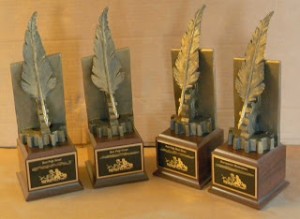Papers and panels on Pulp Studies are sought for the Pop Culture Association/American Culture Association 2014 National Conference being held in Chicago, IL, April 16-19, 2014. Full details here.
CALL FOR PAPERS
Pulp magazines were a series of mostly English-language, predominantly American, magazines printed on rough pulp paper. They were often illustrated with highly stylized, full-page cover art and numerous line art illustrations of the fictional content. They were sold for modest sums, and were targeted at (sometimes specialized) readerships of popular literature, such as western and adventure, detective, fantastic (including the evolving genres of science fiction, fantasy, and horror), romance and sports fiction. The first pulp Argosy, began life as the children’s magazine The Golden Argosy, dated Dec 2, 1882 and the last of the “original” pulps was Ranch Romances and Adventures, Nov. 1971.
The Pulp Studies area exists to support the academic study of pulp writers, editors, readers, and culture. It seeks to invigorate research by bringing together scholars from diverse areas including romance, western, science fiction, fantasy, horror, adventure, detective, and more. Finally, the Pulp Studies area seeks to promote the preservation of the pulps through communication with libraries, museums, and collectors.
With this in mind, we are calling for papers and panels that discuss the pulps and their legacy. Suggested authors and topics:
- Magazines: Amazing Stories, Weird Tales, Wonder Stories, Fight Stories, All-Story, Argosy, Thrilling Wonder Stories, Spicy Detective, Ranch Romances and Adventures, Oriental Stories/Magic Carpet Magazine, Love Story, Flying Aces, Black Mask, and Unknown, to name a few.
- Editors and Owners: Street and Smith (Argosy), Farnsworth Wright (Weird Tales), Hugo Gernsback (Amazing Stories), Mencken and Nathan (Black Mask), John Campbell (Astounding).
- Influential Writers: H.P. Lovecraft, A. E. Merritt, Robert E. Howard, C. L. Moore, Fritz Leiber, Raymond Chandler, Dashiell Hammett, Donald Wandrei, Clark Ashton Smith, and Henry Kuttner. Proposals about contemporary writers in the pulp tradition, such as Joe Lansdale and Michael Chabon are also encouraged. New Weird writers and others, such as China Mieville, whose work is influenced by the pulps, are also of interest.
- Influences on Pulp Writers: Robert Bloch, H. Rider Haggard, Arthur Conan Doyle, Jack London, and Edgar Rice Burroughs were all influences, along with literary and philosophical figures such as Bram Stoker, Mary Shelley, Friedrich Nietzsche, Edgar Allen Poe, and Herbert Spencer.
- Popular Characters: Conan of Cimmeria; Doc Savage; Solomon Kane; Buck Rogers; Northwest Smith; The Domino Lady; Jiril of Jiory; Zorro; Kull of Atlantis; El Borak; The Shadow; The Spider; Bran Mak Morn; Nick Carter; The Avenger; and Captain Future, among others. Also character types: the femme fatale, the he-man, the trickster, racism and villainy (such as Charles Middleton’s Ming the Merciless), and more.
- Artists: Popular cover artists including Margaret Brundage (Weird Tales), Frank R. Paul (Amazing Stories), Virgil Finlay (Weird Tales), and Edd Cartier (The Shadow, Astounding).
- Periods: The dime novels; Argosy and the ancestral pulps; Weird Tales, Amazing Stories, and the heyday of the pulps; the decline of the pulps in the 50s and 60s; pulps in the age of the Internet.
- Theme and Styles: Masculinity, femininity, and sex as related to the heroic in the pulps; the savage as hero, the woman as hero, the trickster as hero, etc.
- Film, Television and Graphic Arts: Pulps in film, television, comics, graphic novels and other forms are especially encouraged. Possible topics could include film interpretations such as Conan the Barbarian, comic book incarnations of pulp magazines and series; “new weird” reinventions of the pulps such as the League of Extraordinary Gentlemen and The Watchmen; fan films; and newer productions, including the recently released Solomon Kane and Conan.
- Cyberculture: Cyberpulps such as Beneath Ceaseless Skies and pulp-influenced games such as the Age of Conan MMORPG or the Call of Cthulhu role-playing game.
These are but suggestions for potential panels and presentations. Proposals on other topics are welcome.
[Via Rick Thomas and Andrew Porter.]


 What would Earle Bergey have thought about this? An Australian company has adapted six 1940’s and 50’s pulp SF magazine covers
What would Earle Bergey have thought about this? An Australian company has adapted six 1940’s and 50’s pulp SF magazine covers